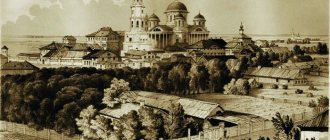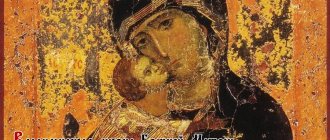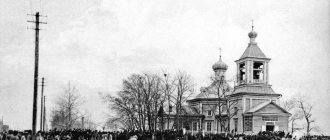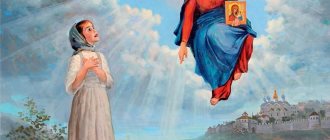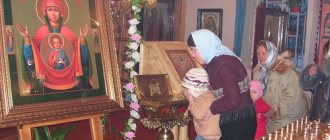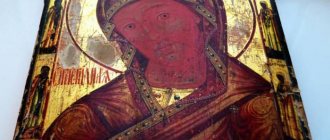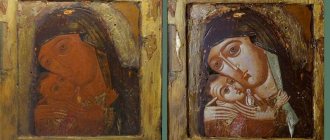History of the Kazan Icon. Finding a shrine
The image of the Mother of God appeared in Kazan in 1579, when this city could still hardly be called Russian. Only 27 years have passed since the capture of Ivan the Terrible by his troops in 1552, and even less since the founding of a separate diocese of the Russian Orthodox Church in 1553. The local population also had little sympathy for such a great event, since it was predominantly Muslim. Moreover, on the eve of the apparition - in June 1579 - the city was engulfed in a terrible fire, and many local residents considered this to be the malicious intent of Christians. Nevertheless, it was in this city and in this turbulent time that the Mother of God revealed Her honest image.
Kazan Bogoroditsky Monastery, Kazan.
Appearance of the Kazan Icon
The phenomenon itself happened as follows. Some time after the fire, one nine-year-old girl - Matrona, the daughter of a archer of the royal army - begins to appear to the Mother of God Herself with the command to find Her image in one of the ashes. After the first appearance of the Mother of God, no one believed the girl. However, the Mother of God appears to Matrona more than once or twice, and the girl continues to turn to adults with a request to find the image. After some time, Matrona’s mother turns to the Orthodox priests with a request for help and a story about the miraculous vision of her daughter. However, the clergy doubt the truth of these phenomena and are in no hurry to find the image. Only after repeated persistent appeals to the Bishop of Kazan, it was decided to find the image of the Most Pure Mother of God. As a result, the image, wrapped in cloth, was found on one of the ashes. According to legend, the image was found only when Matrona herself began digging. At the site where the icon was found, by decree of the tsar, the Mother of God nunnery and church were built, and the first copy of it was sent to Moscow.
TIME OF TROUBLES
The history of the Kazan image in the history of the Time of Troubles is inextricably linked with the feat of St. Hermogenes, Patriarch of Moscow and All Rus', who was one of the first to defend Russia and the Orthodox faith from the invasion of Polish invaders, and equally from internal strife, which, perhaps, They even threatened the country to a greater extent at that time.
The first church, built in the 17th century, honors the Kazan Icon of the Mother of God in the village of Kolomenskoye. Photo from wikimedia.org/Ludvig14
Patriarch Ermogen, by the way, became the author of the “Tale” about the Kazan Icon of the Virgin Mary. This happened when he was still Metropolitan of Kazan in 1594. The full title of the “Tales” is “The Tale and Miracles of the Most Pure Mother of God, the Honest and Glorious Appearance of Her Image, Like in Kazan.” He also composed a service for this icon.
At the end of 1610, the situation in Russia became tense. It is widely known that at this time Polish aristocrats actively laid claim to power in the country, but it is important to remember why this became possible: the main misfortune of the country was not even an invasion from outside, but the anarchy generated by the civil war. Cities and influential boyar clans fought with each other. The country was filled with gangs of Cossacks and simply wandering seekers of easy money, who robbed, raped and killed. People who called themselves Orthodox, if they remained so, then only formally. Many behaved like real barbarians.
Patriarch Hermogenes was taken into custody. It was at this moment, having finally realized the destructiveness of the situation, the saint begins to send out his district messages to all regions of the state, calling for an end to the strife, to unite and to gather militias to liberate the country from enemies. In them, he especially calls not only to defend the country, but also to defend his Orthodox faith, and to prevent violence and cruelty towards ordinary people.
Under the influence of the patriarch’s speeches, a militia is formed in Nizhny Novgorod under the leadership of Prince Dimitry Pozharsky and Kuzma Minin. Soon it begins to move towards Moscow, visiting different cities along the way.
In Yaroslavl, Kazan residents also join the militia, bringing with them a copy of the Kazan Icon of the Mother of God and handing it over to Prince Demetrius. This happened already in 1611. From this moment, in fact, the Most Holy Theotokos becomes the head of the militia as the spiritual leader of the people.
By the autumn of 1612 the situation had become quite complicated. On the one hand, the Poles themselves, who took refuge in the Kremlin, were in a vicious circle - hunger, disease and discord were raging in their camp, and convoys sent to help from the outside were intercepted by the Russian militia. On the other hand, the camp of the Russian militia also had its own unrest. It became obvious that we could wait no longer. On the eve of the storming of the Kremlin, a three-day fast and intense prayer were announced in the ranks of the Russian militia in front of the Kazan image of the Mother of God.
There is an indication in historical sources of a miraculous phenomenon associated with the intercession of the Mother of God. At the time of the siege, Archbishop Arseny of Elasson was in the Kremlin, to whom St. Sergius of Radonezh appeared the night before the assault. According to legend, he told the archbishop the following: “Arseny, our prayers have been heard; through the intercession of the Mother of God, God’s judgment on the Fatherland was transferred to mercy; "Tomorrow Moscow will be in the hands of the besiegers, and Russia will be saved."
The next morning, October 22, 1612, Russian troops stormed Kitay-gorod, and two days later they liberated the entire Kremlin.
On October 25, 1612, Russian militias marched to the Kremlin in a religious procession, carrying ahead the Kazan Icon of the Mother of God, the main Intercessor of the Russian land.
According to the Nikon Chronicle, after the liberation of Moscow from the Polish invaders, Prince Dimitry Pozharsky left the Kazan image of the Virgin Mary in the Church of the Entry into the Temple of the Blessed Virgin Mary on Lubyanka. In 1636, this image was transferred to the newly built Kazan Cathedral on Red Square. This cathedral was also built in honor of the liberation of Moscow from the Poles.
Since 1649, this day, October 22, has become an all-Russian day of celebration in honor of the Kazan Icon of the Mother of God, who defended Russia in the Time of Troubles.
KAZAN IMAGE IN THE WAR OF 1812
In the Patriotic War of 1812, the mercy of the Mother of God towards the Russian people was again manifested, which She showed through Her honest Kazan image.
It is known that before leaving for the active Russian army, Field Marshal Mikhail Illarionovich Kutuzov prayed in front of the Kazan image of the Mother of God.
One of the most famous cases of the War of 1812, associated with the help of the Russian troops of the Kazan image, is the battle of Vyazma on October 22. On this day, which was the day of celebration in honor of the Kazan image, Russian troops of General Mikhail Andreevich Miloradovich and cavalry general Matvey Ivanovich Platov defeated the rearguard of the troops of the French Marshal Davout.
In this battle, in which the French lost about 7–8 thousand people, Napoleon’s army suffered its first defeat after leaving Moscow.
In 1811, the construction of the Kazan Cathedral was completed in St. Petersburg, which after the war of 1812 became a temple-monument to the Russian army. Subsequently, Prince Mikhail Kutuzov was buried in this cathedral. There is no doubt that the place to perpetuate the glory of the Russian army was not chosen by chance, since in the war of 1812 the Most Holy Theotokos, as in the years of the Time of Troubles, became the spiritual guide of the Russian people.
IMAGE STEALING
From the moment of its appearance until the beginning of the twentieth century, the original icon was constantly in the Mother of God Convent of Kazan, that is, at the site of its miraculous appearance. However, when the troubled revolutionary years began for Russia, perhaps, for edification or humility, the Lord deprived her of this miraculous image. Many people of that era showed signs of apostasy from their native faith, from the faith of their fathers. Most likely, this was one of a number of reasons for the tragedy that occurred. Now, many years later, those events can be traced in sufficient detail.
On the night of June 28-29, 1904 (old style), the Kazan image of the Blessed Virgin Mary was stolen.
It is believed that the moment for the theft of the icon was not chosen by chance. For four days preceding the theft, the Smolensk Icon of the Mother of God, brought to the city, was in the monastery. In this regard, long holiday services were held in the monastery every day. On June 28, the Smolensk Icon was taken out of the monastery to return home. At the end of the all-night vigil, the nuns went to their cells. At the beginning of three o'clock in the morning, one of the novices, Tatyana Krivosheeva, went out into the courtyard of the monastery and heard cries for help coming from the direction of the bell tower. It turned out that it was the monastery watchman Fyodor Zakharov who was shouting. He was found locked in the basement of the cathedral.
Captured Bartholomew Chaykin
When examining the cathedral, a place was found through which the thieves got inside. The fact that these were thieves, and not just vandals, became clear when the loss of the Kazan image of the Mother of God and the icon of the Savior was established. Both icons were placed in the iconostasis. The icons were decorated with expensive vestments - this, apparently, attracted robbers. As noted later, in addition to the icons, 365 rubles of donations, which were stored in candle boxes, were also stolen.
The news of the theft of the miraculous image quickly spread not only to Kazan, but throughout Russia. Fortunately, thanks to the caretaker of the Aleksandrovsky vocational school Vladimir Volman (he gave the police very valuable information), the criminals were quickly found. As a result of coordinated, and most importantly, quick actions of all people who were not indifferent to this misfortune, the police very soon found the main suspect - a 28-year-old peasant, Bartholomew Chaikin (Stoyan). Already on July 5, he, together with his wife Praskovya Kucherova (officially she was his partner), was detained in Nizhny Novgorod, where they tried to escape from Kazan on the Niagara steamer.
During a search of Chaikin’s apartment, jewelry and pieces of decoration from the icons of the Virgin Mary and the Savior were discovered. However, the icons themselves were not found. According to 9-year-old Evgenia, the daughter of Chaikin’s partner, the icons were chopped up and burned in the stove. Similar evidence was given by several other persons who served as witnesses - in particular, it was Praskovya’s mother, Elena Schilling.
On November 25, 1904, the trial began in the Kazan District Court. Bartholomew Chaikin (Stoyan), Anania Komov (both direct participants in the crime), Fyodor Zakharov, Nikolai Maksimov (closest accomplices), Praskovya Kucherova and Elena Shilling (both who concealed the crime) appeared before the court as defendants.
After lengthy hearings, by a court decision, Bartholomew Chaikin (Stoyan) was sentenced to 12 years of hard labor, Anania Komov - to 10 years. Maksimov was sentenced to exile for 2 years 8 months in correctional prison units. Praskovya Kucherova and Elena Schilling were sentenced to 5 months and 10 days in prison. The watchman Fyodor Zakharov, who was suspected of complicity, was acquitted.
The main version of the fate of the icon was that it, like the image of the Savior, was burned by attackers. However, over time, other versions began to appear. For example, some suggested that Chaykin could have sold the icon to the Old Believers, since even without the frame it was very expensive. Her true fate is still unclear.
What do they pray to the Mother of God for?
About marriage
In Rus', it has long been customary to bless children for marriage with the Kazan Icon. This is due to the fact that the autumn celebration of the image took place at the end of the autumn work, after which weddings were traditionally held. On this basis, girls often prayed before Kazanskaya for the gift of a husband.
About family
The Mother of God in Her Kazan image has also long been revered as the patroness of married life. Therefore, people resort to Her when there are difficulties in family relationships. After all, the image - a blessing for marriage - always takes pride of place among household icons.
About conceiving and maintaining pregnancy
There are many known miracles from the image associated with the birth of children in previously infertile couples, as well as with the miraculous birth of healthy babies when doctors’ prognosis is unfavorable.
The poet S.M. Gorodetsky (1884-1967), speaking about the special patronage of the Most Pure women, wrote:
At the Kazan Mother of God
The eternal gaze is wonderfully bright,
Wives, daughters and mothers
They stand in front of her with a prayer.
About children
The fact that the icon first appeared to a child, Matrona, prompts many people to make petitions for the well-being of children in front of Kazanskaya. Through this image, the Most Pure One actually provides many benefits to children.
It is worth noting that for many years Kazan was not only a military and spiritual, but also a cultural outpost of Russia in the East. It was the educational institutions of this city that were the “curators” of the gymnasiums and schools of the newly annexed Siberia. And when the first university opened here in 1888 (in Tomsk), the bulk of its teachers were again professors from Kazan. It is therefore clear that the house church of the first university was dedicated to the Kazan shrine. Since then, in Siberia it has been customary to strictly pray to this image for the success of children - be it a schoolchild or a student at a technical school or higher educational institution.
About health
Many miracles, from the very first days after the discovery of the shrine, convince believers to turn to Kazanskaya during illnesses - their own or those of loved ones. Cases of returning lost vision are especially common. But other miracles are also known that are associated with the punishment of blasphemers or criminals, and blinding is also most often used as such.
“Do not be afraid, I am your Intercessor!”
In 1812, the wealthy noblewoman Maria Adenkova, who decided to leave the world, went to the Vyshensky Monastery of the Ascension of the Lord near Tambov. The only property she had with her was the Kazan Icon. The cab driver carrying the woman decided to rob her. Seeing that he was up to something bad, she began to pray to the Mother of God, and suddenly heard Her voice: “Do not be afraid, I am your Intercessor!” Following this, the would-be robber suddenly became blind. Shocked, he repented with tears, after which he was immediately pardoned.
There is also an attempt to dismantle the Kazan Church at the former Zhadovskaya Monastery (now Ulyanovsk region), which was abolished in 1764. The workers who came, as well as the priest who was with them, lost their sight, which returned only after they promised to leave the bad deed.
About work
Such addresses in front of the shrine have also been known for a long time. They are also associated with the autumn celebration of the image. Then not only field work ended, but also construction and other work for which peasants were hired. According to a common saying, “Kazanskaya is the way to go!” Promises of payment for work specifically “on Kazanskaya” were almost never broken, because the Most Pure One Herself was their guarantee.
Where is the Kazan Icon located?
NOWADAYS. RETURN
The story of the Kazan Icon has taken a new turn in our days. In 2004, the Vatican received a proposal for a meeting between Pope John Paul II and His Holiness Patriarch Alexy II. The pretext was the presence at the papal court since 1993 of an image of the Blessed Virgin Mary of unknown origin. After analyzing the situation, art historians came to the conclusion that this icon is one of the copies of the Kazan image.
The Kazan Icon of the Mother of God (pictured) was returned to Kazan. Itar-Tass Photos
And although the meeting between the Patriarch and the Pope never took place, in August 2004 the icon was delivered to Moscow by a Catholic delegation headed by Cardinal Walter Kasper. On August 28, it was handed over to Patriarch Alexy II in the Assumption Cathedral of the Moscow Kremlin. It was decided to move the image to Kazan, and until that time it was kept in the residence of the patriarch.
In July 2005, while on an archpastoral visit to Kazan, Patriarch Alexy II celebrated the Liturgy in the Annunciation Cathedral of the Kazan Kremlin. At the end of the service, the Kazan Icon of the Mother of God, brought from the Vatican, was handed over to the Kazan diocese. The icon was placed where the original once stood - in the Church of the Exaltation of the Cross of the former Mother of God Monastery. Thus, we can say that the second discovery of the image of the Mother of God took place in Kazan.
The fate of the image
The glorified image had dozens of copies, which were also famous for working miracles. These images are known in:
- Moscow (1579);
- Yaroslavl (1588);
- Tobolsk - a revealed icon, known since 1661; Kazan was considered one of the most revered in Siberia, where dozens of temples dedicated to the shrine were built;
- in many other cities.
As for the most revealed Kazan icon, on July 12, 1904, it was stolen from the Kazan temple dedicated to it. Apparently, the thieves were attracted by the expensive salary and jewelry donated by grateful believers: after all, their cost reached up to 10,000 rubles.
The prototype of the icon has not yet been found. Now in Kazan there is a list called the Vatican, according to the place where this icon was kept in the 1960-1970s. Created, as established, in the 18th century, it was transferred to Kazan, to the monastery of the Most Holy Theotokos, which once arose on the site of the discovery of the shrine, and has now been revived. The icon has been here since 2005.
Iconography
Kazanskaya belongs to the so-called “abbreviated” type of Hodegetria. This means that the image of the Mother of God with Christ is not half-length, but only shoulder-length; the hands of the Most Pure One pointing to the Son and Christ blessing those praying are not visible on it. There are two versions of the appearance of such images:
Russian icon painters copied Greek miraculous images, in which, according to pious tradition, it was customary to cover the lower part with a curtain;
Kazan, like other similar icons, is one of the images that were written for those setting off on a military campaign or journey; such images, called “prayer” images, that is, created for cell and not cathedral prayer, were very small, the size of a span (about 4 inches or about 18 cm); Indeed, the original of Kazan is not much larger - 26.7x22.3 cm, and besides, Kazan is a city where there were many military people, just newcomers, who took prayer images with them.
However, subsequent lists of Kazan were made, as a rule, much larger in size than the revealed shrine.
Lists of the Kazan Icon
The icon of the Holy Trinity Cathedral is one of the ancient copies of the miraculous prototype. This image was painted in the 18th century. Subsequently, the icon was rewritten several times. The original image was hidden by several layers of later recording. In 2005, the icon was restored.
Throughout Russia itself there were many revered copies of the Kazan Icon of the Mother of God. The history of the veneration of this image is largely connected with them.
LIST IN THE MILITARY
For example, one of the revered copies of the Kazan Icon was constantly in the camp of the Russian militia of Prince Dimitry Pozharsky during the war with the Polish and Swedish invaders in 1611–1613. In memory of the liberation of Moscow from Polish troops, it was established to hold a special celebration in honor of the Kazan Icon of the Mother of God on October 22. At first, the celebration took place only in Moscow, but since 1649 the celebration has become all-Russian.
Around the same time, the first church was built in honor of the Kazan Icon of the Mother of God in the village of Kolomenskoye.
PETERSBURG LIST
In the 18th century, both Peter I and Catherine the Great showed their attention and respect for the image of the Mother of God. So, for example, it was under Peter I, in 1721, that one of the revered copies of the Kazan Icon was brought to St. Petersburg. And earlier, in 1709 (on the eve of the Battle of Poltava), the entire Russian army, led by the emperor, prayed before the Kazan Icon for victory. In 1768, the original icon, located in Kazan, was especially venerated. Empress Catherine the Great decorated the frame of the image with a diamond crown.
The shrine of St. Petersburg, brought to the city in the first days of its creation by Peter I. Located in the Kazan Cathedral.
By the end of the 19th century, the Kazan icon became one of the most revered in Russia. Moreover, this applies to the entire Orthodox population of the country. It would hardly be possible to find a believer at that moment who did not know the Kazan image of the Virgin Mary or at least one of its many revered copies.
Kazan miracle: first healings
People came running to the place of the extraordinary event, finally the priests came, and then the Kazan ruler Jeremiah. In a procession of the cross, the new shrine was carried to the nearby church of St. Nicholas. Many Orthodox Christians, crowding each other, tried to see the image and touch it. And not in vain: healings began to flow from the icon even then, on the very first day after its appearance.
Miraculously, two blind men, God's servants Joseph and Nikita, received sight. At the same time, Joseph, instead of thanking the Lady, “attempted to ask for silver again,” trying to extract more benefit from what happened. Patriarch Hermogenes, a participant in the discovery of the holy image, writes that Joseph immediately lost his sight, only “from ignorance for the sake of his small path to see.” And the people, shocked by the miracle and the quick admonition of the ungrateful man, had even greater faith in the shrine.
In total, during the first days after the appearance of the shrine, there were 16 recorded miracles. Most of these were healings from blindness, as well as relaxation (paralysis), and leg diseases.
Guardian of the country
Already since 1579, the list of icons has been known in the capital. It is believed that they made it for Tsar Ivan IV, who learned about the miracle. By his order, a convent was built at the site of the appearance of the image. The first to be tonsured here were Matrona (in monasticism - Moor) and his mother. But still the holy image remained almost until the end of the 16th century. was revered only as a local shrine.
Only in 1594 did a legend appear about the discovery of the icon, written for Emperor Theodore Ioannovich by then Metropolitan Hermogen of Kazan, who once carried the found shrine during the first religious procession. 8 years later, already at the height of the Time of Troubles, the Kazan Bishop, by the will of God, became the Patriarch of the Russian Church. It is from St. Hermogenes is credited with the beginning of the all-Russian veneration of the holy image:
- by his order, a list of Kazan (1611) was brought to the walls of the capital captured by the Poles, where the people’s militia was stationed; the image was greeted without respect; many later said that the consequence of rejecting the help of the Mother of God was the defeat of the people’s militia, which was trying to liberate Moscow;
- the list of the icon became the “Hodegetria” of the second militia of Prince Dimitry Pozharsky; On November 4 , 1612, his troops, presenting the shrine, entered Red Square.
By this time St. Hermogenes was no longer alive: he suffered martyrdom at the hands of the Polish interventionists, who starved the saint to death. And Kazan has firmly taken its place among the main shrines of the Russian Church. For her list, a temple dedicated to the miraculous image was built on Red Square.
Kazan icon in Moscow
Patriarchal service on the feast of the Kazan Icon of the Mother of God in the Kazan Cathedral on Red Square
In the Russian capital there are many churches where you can pray before the icon of the Kazan Mother of God. First of all, this is the Kazan Cathedral on Red Square. The temple was restored in 1993. Here is the revered image of the Kazan Icon.
At the bottom of the Cathedral of Christ the Savior in the Church of the Transfiguration of the Lord there is a recently painted Kazan Icon of the Mother of God. Parishioners of the capital's cathedral often pray in front of it.
In the Church of the Prophet Elijah in Obydensky Lane, among the shrines you can find the Kazan Icon. There is also a piece of the belt of the Blessed Virgin Mary. The temple is open daily from 07.00 to 22.00.
In the Yelokhovsky Cathedral near the Baumanskaya metro station there is a copy of the miraculous Kazan Icon of the Mother of God, which was previously in the Kazan Cathedral on Red Square.
Kazan Icon of the Mother of God with St. Timothy and Mary Magdalene in the fields. Russia, late 18th century
In the Church of the Intercession of the Mother of God on Lyshchikova Mountain between the Kurskaya and Taganskaya metro stations, you can also pray in front of the Kazan Icon. And also venerate the relics of priest Roman Medved, who died in the late 30s in Maloyaroslavets after numerous arrests and exiles.
In the Church of St. Pimen the Great near the Novoslobodskaya metro station you can see the Kazan Icon painted on glass.
The Church of St. Nicholas the Wonderworker on Bersenevskaya Embankment near the Kremlin is one of the most unusual in Moscow. Long services with many Old Believer traditions are held here. In the church you can pray in front of the revered copy of the Kazan Icon.
Of course, these are not all churches in the capital where there is this image of the Virgin Mary. It is more difficult to find a church in Moscow where there is no Kazan Icon of the Mother of God.
__________________________________________________________
It is best to pray to the holy face in the morning and with good intentions
How to pray in front of the Holy Image:
In order for the Mother of God to hear the request, you need to pray to her correctly. This can be done both in the temple and at home. If you want to ask the holy image of your home for help, it is best to pray in the morning:
- In the morning after waking up, wash yourself well with water, cross your hands in advance and set yourself up for positive emotions;
- calm down and get rid of all annoying and negative thoughts from your head;
- light the candles, kneel down and then begin the ritual;
- The number of times prayers are said is not the most important thing, but what is important is that all the words of the prayer are spoken sincerely, from a pure heart;
- After you have prayed, you can express your petition to the Mother of God. But remember that a request will not be heard if it contains at least one negative wish.
By leaving a comment, you accept the user agreement
Description of the Kazan Icon
The Kazan icon is a shortened (shoulder-length) version of the image of the Hodegetria (Guide) type. The Child Christ sits in the arms of the Mother of God, with His right hand He blesses, and with His left He holds a scroll, or less often, a book.
On the Kazan Icon, the Mother of God is depicted with a full chest, in characteristic clothes, with a slight inclination of her head towards the Infant God. Christ looks directly at the man in front of the icon, the Savior is depicted from the waist up, only his right hand is visible with a blessing gesture.
For more information about the iconography of the Kazan Icon of the Mother of God, see here .
Kazan Icon: How the Mother of God Helps
Kazan Icon of the Mother of God. Moscow, first half of the 18th century.
According to the teachings of the Orthodox Church, one cannot assume that this or that icon helps with anything. Metropolitan Anthony of Sourozh said that a newly painted image becomes a shrine only after its consecration. Until this point, the new icon is simply an image of Christ, the Mother of God or a saint, which is made with paints on wood. Christians do not worship the material with which this or that image is painted. At the VII Ecumenical Council, the dogma of icon veneration was adopted. It directly states that “the honor given to the image passes to the original, and the one who worships the icon worships the being depicted on it.”
Another thing is that some icons are considered miraculous, since Christ, through prayers in front of certain shrines, helps people and entire nations. Therefore, the Kazan Icon of the Mother of God was especially revered in Rus', and the Mother of God, through the prayers of people in front of her image, more than once healed the sick or saved the country from destruction.
Prayer before the icon of the Kazan Mother of God has saved Russia more than once. This was the case at the beginning of the 17th century, when Moscow was captured by the Poles. In the militia of Minin and Pozharsky there was a miraculous image of the Mother of God, and after fervent prayers people were able to liberate the Kremlin from the invaders in 1613.
In 1812, Russia was attacked by Napoleon’s army, and again prayer in front of the image of the Kazan Mother of God helped to cope with the invaders. The army of thousands of the famous commander fled from Russia.
The same thing happened during the Great Patriotic War. There are several stories about how the Mother of God helped people survive the horrors of war, and soldiers helped defeat a terrible enemy. Prayer helped soldiers in battles.
_________________________________________________________
Story
Once revealed to the distant outskirts of the country, now this is perhaps Russia’s most beloved icon of the Mother of God. Kazan is a kind of symbol, the hope of the country during trials, a sign of the Most Pure One’s love for Her “home,” which Rus' has always been called.
8
July
1579
In the city of Kazan, conquered by Tsar Ivan IV less than 20 years earlier, a miraculous image of the Mother of God appeared.
No one expected this event or expected it. Not long before there was a terrible fire that destroyed a significant part of the then wooden city. Local Muslims openly said: God is punishing the Orthodox who came to their ancestral land. The faith of Christians became “a parable and a reproach,” according to the words of the Kazan priest Ermolai (in the future, the primate of the Russian Church, Hermogenes).
From the bowels of the earth
Iconography: Kazan Icon of the Mother of God Dates: XVII century. Second quarter of the 17th century. Origin: From the Spaso-Prilutsky Monastery near Vologda. Material: Wood, gesso, tempera. Dimensions of the icon: height 37.5 cm, width 32 cm. Icon in frame. In the middle there is a depiction of the Mother of God and Child. In the margins are images of Saints Gurias and Barsanuphius. VOKM 5474 ©Vologda State Historical, Architectural and Art Museum-Reserve.
Then the Kazan archer, whom the “Legend” about the acquisition of the image calls “a certain simple husband,” Daniil Onuchin, was rebuilding his house in the conflagration. Busy with construction, he and his wife did not immediately pay attention to the stories of their daughter, 10-year-old Matrona. She kept repeating that the Mother of God Herself appeared to her in a dream, commanding her to find her holy icon in the conflagration.
The third, and last, appearance of the Most Pure One turned out to be formidable: the Mother of God directly demanded that Her icon be found. Only after this did the girl’s mother rush first to the priests, and therefore to the bishop himself. But the church authorities also did not pay attention to the child’s words. No matter how much the woman told her neighbors about everything that happened, just passers-by on the street, they all, as the legend says, “marveled at her words and walked away without paying attention to her speech.”
Then Matrona and her mother themselves began excavations at the site of the burnt house. Here, at about a meter deep, they found an icon neatly wrapped in cloth. Apparently, having lain in the ground for years, it, however, looked clean, as if it had just been painted by a master.
Prayer before the Kazan Icon
Prayer before the Icon of the Mother of God “Kazan” (October 22/November 4 and July 8/21)
O Most Holy Lady Theotokos! With fear, faith and love before Your honest (and miraculous) icon, we pray to You: do not turn Your face away from those who come running to You. Pray, merciful Mother, to Thy Son and our God, the Lord Jesus Christ, to keep our country peaceful, and to keep His Holy Church unshakable from unbelief, heresies and schism let him deliver. There are no other help, no other hope, except You, Most Pure Virgin: You are the all-powerful Helper and Intercessor of Christians. Deliver all those who pray to You with faith from the falls of sin, from the slander of evil people, from all temptations, sorrows, illnesses, troubles and from sudden death. Grant us the spirit of contrition, humility of heart, purity of thoughts, correction of sinful lives and the remission of sins, and all of us, gratefully chanting Your greatness and mercy, which are revealed to us here on earth , let us be worthy of the Heavenly Kingdom, and there with all the saints we will glorify the most honorable and magnificent name Father, and Son, and Holy Spirit forever and ever. Amen.
All-Russian shrine
Subsequently, the icon became famous for its miracles of help at the most critical moments in the history of the state:
- a copy of the image, called “Kaplunovskaya”, at its location, the village of Kapluny, was transferred to the Russian army in 1709, on the eve of the Battle of Poltava; troops under the leadership of Emperor Peter I then won a brilliant victory over the Swedes; it was then that the idea of building a cathedral church in the new Russian capital, St. Petersburg, appeared;
- in 1812, Kazanskaya again took part in hostilities, this time during Napoleon’s invasion; November 4, the day of her memory, was also the beginning of a disaster for the enemy army: snow fell and frost hit, which helped the Russian troops finally defeat the invaders; the memory of the help of the Most Pure One was the construction of the Kazan Cathedral in St. Petersburg, conceived by Peter I;
- There are also many known miracles of Kazan during the Great Patriotic War - among them both the fencing of St. Petersburg (then Leningrad) from the enemy, and cases of rescue of soldiers and officers during battle.
Troparion of the Kazan Icon
Troparion of the Kazan Icon of the Mother of God, tone 4
Zealous intercessor, Mother of the Most High Lord. Pray for all, thy Son Christ our God, and cause all to be saved, into thy sovereign protection for those who flee. Intercede for us all, O Lady Queen and Lady! even in adversity and sorrow, and in illness, burdened with many sins, coming and praying to you with a tender soul and a contrite heart, before your most pure image with tears, and irrevocably hope I am waiting for those who have it, for the deliverance of all evils. Grant what is useful to everyone, and save everything, O Virgin Mary: for you are the divine protection of your servant.
